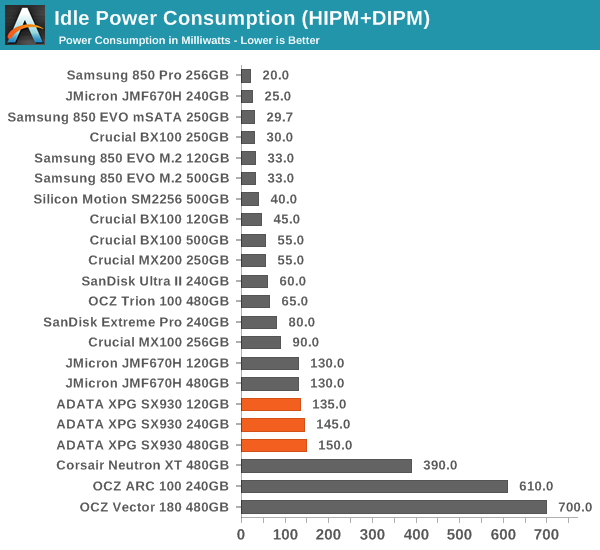ADATA XPG SX930 (120GB, 240GB & 480GB) SSD Review: JMicron JMF670H Debuts
by Kristian Vättö on July 16, 2015 10:00 AM ESTIdle Power Consumption
Since we truncate idle times to 25µs in our Storage Bench traces, they don't give a fully accurate picture of real world power consumption as idle power consumption is not taken properly into account. Hence I'm still reporting idle power consumption as a separate benchmark because it's one of the most critical metrics when it comes evaluating an SSD for mobile use.
Unfortunately I still don't have a way to test DevSleep power consumption due to lack of platform support, but my testbed supports HIPM+DIPM power commands (also referred to as Slumber power), so the results give a rather accurate picture of real-world idle power consumption.

Compared to the reference samples, the SX930 isn't as low power as it could be. I suspect this is due to ADATA's optimizations, which could be to increase compatibility as some systems have issues with power saving states. Still, I would like to see the power saving settings in place because as it stands the SX930 consumes more power at idle than the competing drives with HIPM+DIPM support.
TRIM Validation
The move from Windows 7 to 8.1 introduced some problems with the methodology we have previously used to test TRIM functionality, so I had to come up with a new way to test. I tested a couple of different methods, but ultimately I decided to go with the easiest one that can actually be used by anyone. The software is simply called trimcheck and it was made by a developer that goes by the name CyberShadow in GitHub.
Trimcheck tests TRIM by creating a small, unique file and then deleting it. Next the program will check whether the data is still accessible by reading the raw LBA locations. If the data that is returned by the drive is all zeros, it has received the TRIM command and TRIM is functional.











67 Comments
View All Comments
dada121 - Thursday, July 16, 2015 - link
First to take the throne,Refuge - Thursday, July 16, 2015 - link
can't wait for NVMe to give us some space to stretch our legs again! :)Stochastic - Thursday, July 16, 2015 - link
Just how much of an impact are NVMe drives expected to have on light tasks, e.g. boot times, application and game load times, etc. Could the average consumer benefit from a move to ultra high performance NVMe drives, or are the benefits limited to power users?Refuge - Thursday, July 16, 2015 - link
It is definitely more limited to power users. Especially until NVMe support and drives go down in costs. Right now it is enterprise or enthusiast only.But that is just par for the course. Software will be developed to use the extra horsepower one day, but not until after that level of performance is much more common place.
SATA6 SSD's will be perfect for regular consumers for years to come. But I see in a couple years especially with how graphics resolutions are going through the roof that Gamers will start finding a use for the extra bandwidth once 4k gaming is mainstream and texture packs start to explode like they did back in the 90's.
Remember when a 16g HDD running at 5400 RPM was the SHIT!?
TelstarTOS - Tuesday, July 21, 2015 - link
Yeah, in those times i had SCSI :)Adding-Color - Thursday, July 16, 2015 - link
They could be useful for video editing and other stuff that profits from fast sequential reads/writes.For games not so much. Most games appear to be CPU limited not SSD disk limited (for load times, when you are using a SSD) and a recent review (forgot the link) showed almost no load times improvement using a 2GB/s NVME Pcie SSD compared to a 500MB/s SATA SSD.
From a power and and efficiency standpoint NVME should have less latency and less lower consumption.
Impulses - Thursday, July 16, 2015 - link
Content creation tasks, even with photos instead of video, can already benefit greatly from NVMe or M2/PCI-E in general... I'm getting a smaller M2 Samsung drive as soon as I have a mobo that supports it (Skylake?), not sure I see myself going for a large one until prices drop well under $1/GB tho, and that'll take a while.For a power user I think an M2/PCI-E SSD for OS/apps/scratch space + large SATA SSD drive/array for data will soon supplant the SATA SSD + HDD setups... But M2/PCI-E will be like the Raptors of the SSD world.
AnnonymousCoward - Thursday, July 16, 2015 - link
Stochastic, you won't find the answer here, since AT doesn't do real world SSD testing.benzosaurus - Sunday, July 19, 2015 - link
Half of their benchmarks are literally recordings of the writes generated by doing real world things.AnnonymousCoward - Sunday, July 19, 2015 - link
Irrelevant. Stochastic asked how boot times and app load times compare.